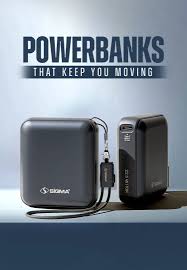In our increasingly digital world, staying connected is paramount. Our smartphones, tablets, smartwatches, and other gadgets are constantly in use, and their batteries often struggle to keep up with our demanding schedules. This is where power banks step in as indispensable companions, offering a portable and convenient solution to keep your devices charged, no matter where you are.
What is a Power Bank?
A power bank (also known as a portable charger or external battery pack) is a portable device that contains a battery cell (or multiple cells) that can store electrical energy. You charge the power bank from a wall outlet, and then you can use it to charge your electronic devices via a USB cable when you’re away from a power source.
Why a Power Bank is a Must-Have Gadget
Power banks have become essential for modern life for several reasons:
- Uninterrupted Connectivity: Ensures your phone doesn’t die during important calls, navigation, or emergencies.
- Travel Companion: Perfect for long flights, road trips, camping, or any time you’re away from an outlet.
- Work and Study: Keeps laptops, tablets, and other productivity tools powered during commutes or remote work.
- Outdoor Activities: Ideal for hikers, photographers, or anyone spending extended time outdoors.
- Emergency Preparedness: A reliable power source during power outages.
- Multi-Device Charging: Many power banks offer multiple ports, allowing you to charge several devices simultaneously.
Key Factors to Consider When Buying a Power Bank
Choosing the right power bank involves understanding a few key specifications:
- Capacity (mAh): Measured in milliampere-hours (mAh), this indicates how much charge the power bank can store.
- 2,000-5,000 mAh: Good for a single emergency phone charge.
- 5,000-10,000 mAh: Ideal for 1-2 full phone charges or charging smaller devices multiple times.
- 10,000-20,000 mAh: Great for multiple phone charges, tablets, or small laptops.
- 20,000+ mAh: High-capacity, suitable for charging laptops, multiple devices, or extended trips.
- Tip: Check your device’s battery mAh to estimate how many charges you’ll get.
- Output Ports and Speed (Amps/Watts):
- USB-A: Standard port. Look for 2A or higher for faster phone charging.
- USB-C (PD – Power Delivery): Essential for fast charging modern smartphones, tablets, and laptops. Look for higher Wattage (e.g., 18W, 30W, 45W, 60W, 100W).
- Quick Charge (QC): Qualcomm’s fast-charging standard, compatible with many Android phones.
- Input Port and Charging Speed: How fast the power bank itself recharges. USB-C PD input is fastest.
- Size and Portability: Balance capacity with portability. Smaller mAh often means smaller size.
- Safety Features: Look for protection against overcharging, over-discharging, short circuits, and overheating. Reputable brands prioritize safety.
- Build Quality: Durable casing (e.g., aluminum, robust plastic) for longevity.
- Pass-Through Charging: Allows the power bank to charge itself while simultaneously charging a device.
Maintenance Tips for Your Power Bank
To ensure your power bank lasts long and performs optimally:
- Avoid Extreme Temperatures: Don’t leave it in direct sunlight or very cold environments.
- Charge Regularly: Don’t let it sit completely empty or fully charged for very long periods. A 50-80% charge is ideal for storage.
- Use Quality Cables: Cheap cables can hinder charging speed and efficiency.
- Don’t Drop It: Physical damage can harm the internal battery cells.
Conclusion
A power bank is no longer a luxury but a fundamental tool for anyone living a connected life. By understanding your charging needs and the key features of different models, you can select the perfect portable power solution to keep all your devices ready for action, ensuring you’re never left powerless on the go.







0jgsdi
at93z0
bcuol5
wiap2z
Heard some buzz about zt9398. Gave it a whirl, the website’s a bit clunky, but some of the games are pretty fun. Worth a peek at zt9398 if you’re bored.
Ready to roll the dice at 7betcasino! I’m expecting a smooth experience and some exciting games. Let’s see if lady luck is on my side! Check it out: 7betcasino